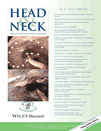Orthotopic VX rabbit tongue cancer model with FDG–PET and histologic characterization
Abstract
Background
We present our experience with the use of an immunocompetent medium-sized animal model of tongue cancer that may be suitable for imaging and surgical studies.
Methods
A New Zealand white rabbit model of tongue cancer was created by injecting a VX tumor cell suspension grown in culture into the tongue of our model. The tumor was examined 7 days following implantation by physical examination, photography, and 18fluoro 2-deoxyglucose–positron emission tomography (FDG-PET). At 12 days postimplantation, the model was again studied as described above prior to euthanization, and then tongue excision and bilateral neck dissections were performed. All tissue was examined by histology.
Results
We confirmed a successful orthotopic tongue cancer model that resulted in cervical nodal metastases.
Conclusion
This model may be a useful model of orthotopic head and neck cancer for future surgical or imaging research. © 2012 Wiley Periodicals, Inc. Head Neck, 2013




